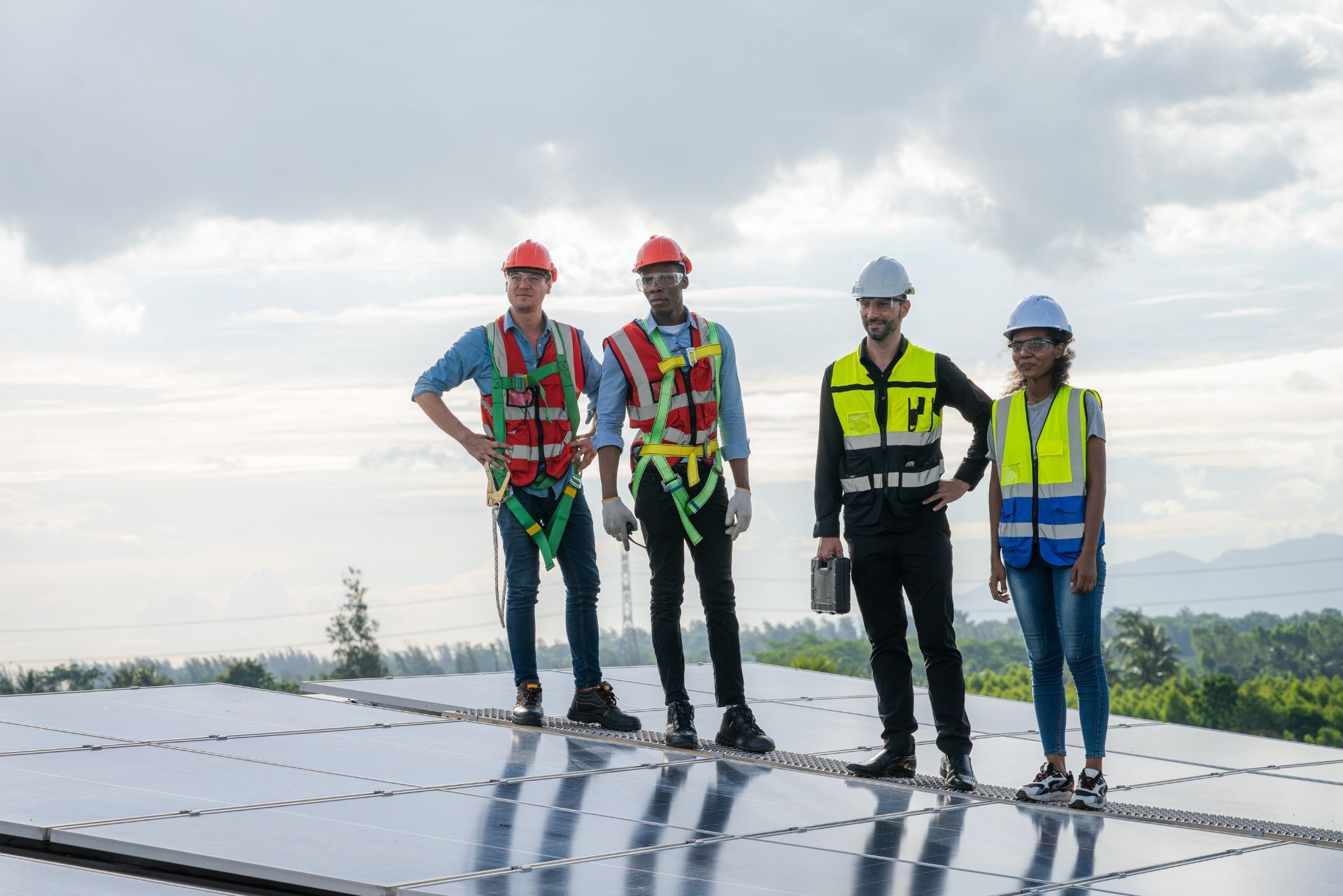New York Solar Installation Company Insurance
See How We're Different:
or Call Us: 212-425-8150

Most Common Business Policies
Index
Managing Financial Risks Through Smart Planning
Ensuring Workforce Stability and Fair Labor Practices
Addressing Operational Risks with Technology and Storage Solutions
Leveraging New York’s Community Solar Market
Preparing for Industry Fluctuations and Long-Term Sustainability
Contact Us
For solar installation companies in New York, the promise of clean energy comes with its own set of challenges. While the state’s booming community solar market offers tremendous opportunity-New York leads the nation with more than 1.9 gigawatts of operational capacity-businesses must navigate risks that could threaten their growth and reputation. Protecting your company means more than just installing panels; it requires a strategic approach to managing financial, operational, and workforce-related risks.
Understanding these risks and how to mitigate them is essential for long-term success. This article explores key strategies that solar installers can use to safeguard their business while capitalizing on New York’s expanding solar market.
Managing Financial Risks Through Smart Planning
One of the biggest draws for businesses switching to solar in Long Island is the dramatic reduction in electric bills. Over 85% of these businesses see their bills drop to zero within the first year. This creates a strong incentive for commercial clients but also raises the stakes for installers who must deliver reliable, cost-effective solutions.
Financial risks for solar companies often stem from project delays, equipment failures, or underperforming systems. To protect against these, companies should invest in thorough site assessments and realistic project timelines. Accurate forecasting of costs and returns helps avoid budget overruns that can jeopardize cash flow.
Additionally, offering warranties and maintenance plans can build trust with clients and reduce liability. These services reassure customers that their investment is protected, which in turn protects the installer’s reputation and revenue stream.
Keeping up with market trends is equally important. The U.S. solar market installed 8.6 gigawatts of capacity in Q3 2024 alone, marking a 21% increase from the previous year. Staying informed about such growth helps companies anticipate demand and scale operations effectively. For more detailed market insights, the Solar Energy Industries Association’s report is a valuable resource.
Moreover, understanding the regulatory landscape can also play a crucial role in mitigating financial risks. With various incentives and rebates available at both state and federal levels, solar companies must navigate these opportunities carefully. For instance, the Investment Tax Credit (ITC) allows businesses to deduct a significant percentage of their solar installation costs from their federal taxes, making solar investments even more attractive. Staying updated on legislative changes can help companies leverage these incentives effectively, ensuring that they remain competitive in a rapidly evolving market.
Finally, fostering strong relationships with suppliers and financial institutions can further enhance a solar company's stability. By negotiating favorable terms with equipment manufacturers and securing reliable financing options, businesses can better manage their cash flow and reduce the risk of unexpected expenses. Building a network of trusted partners not only strengthens operational capabilities but also enhances the overall resilience of the company in the face of market fluctuations.

Ensuring Workforce Stability and Fair Labor Practices
The solar industry’s rapid expansion has created many jobs, but not all come with fair conditions. Lara Skinner, Executive Director of the ILR School’s Climate Jobs Institute, highlights the need to focus on job quality and equitable treatment of workers. Solar installation companies that overlook this risk may face high turnover, low morale, and reputational damage.
New York’s solar sector is seeing innovative labor models, such as the minority worker-owned firm S.U.N.S., which aligns its work with environmental and social justice values. This approach not only supports fair labor but also attracts clients who prioritize ethical business practices. By fostering a sense of ownership among workers, these companies are not only enhancing job satisfaction but also promoting a culture of accountability and commitment to quality, which ultimately benefits the entire industry.
Solar companies should invest in training programs, fair wages, and safe working conditions to build a loyal, skilled workforce. Doing so reduces risks related to labor disputes and compliance violations. It also positions the company as a leader in a competitive market. Furthermore, as the demand for renewable energy grows, companies that prioritize their workforce will likely find themselves better equipped to meet the challenges of scaling operations while maintaining high standards of worker welfare.
In addition to these practices, companies can benefit from establishing partnerships with local community organizations and educational institutions. By collaborating on workforce development initiatives, they can create pathways for underrepresented groups to enter the solar industry. This not only enriches the talent pool but also strengthens community ties and enhances the company’s reputation as a socially responsible entity. Engaging in such community-oriented efforts can lead to a more diverse workforce, which has been shown to drive innovation and improve problem-solving capabilities within organizations.
For a deeper look at how labor models are evolving in New York’s solar industry, check out the Engineering News-Record article.
Addressing Operational Risks with Technology and Storage Solutions
Operational risks in solar installation include weather variability, equipment downtime, and grid integration challenges. These can affect system performance and customer satisfaction. One way to mitigate these risks is by integrating battery storage solutions.
A recent study on battery storage systems shows they can reduce renewable energy curtailment by 34% and load shedding by 21%. This means solar installations paired with storage are more resilient and reliable, especially in grids dominated by renewable sources. Furthermore, battery storage systems can provide ancillary services to the grid, such as frequency regulation and voltage support, enhancing overall grid stability. By enabling solar installations to store excess energy generated during peak sunlight hours, these systems ensure that energy is available for use during periods of low generation or high demand, thus balancing supply and demand more effectively.
Investing in advanced monitoring and predictive maintenance tools also helps detect issues before they escalate. This proactive approach minimizes downtime and costly repairs, protecting both the installer’s bottom line and client relationships. These tools utilize machine learning algorithms to analyze data from solar panels and inverters, identifying patterns that may indicate potential failures. By addressing these issues early, installers can schedule maintenance during off-peak hours, reducing the impact on energy production and enhancing customer trust. Additionally, the integration of IoT devices allows for real-time tracking of system performance, enabling installers to respond swiftly to any anomalies.
More on the benefits of battery storage in renewable grids can be found in this
technical study.
Leveraging New York’s Community Solar Market
New York’s community solar market is the largest in the country, with over 1.9 gigawatts of operational capacity—more than twice that of the second-place state, Minnesota. This market offers solar companies an opportunity to reach customers who cannot install panels on their own properties, such as renters or those with shaded roofs. By providing access to solar energy, community solar projects not only promote environmental sustainability but also empower individuals and communities to take control of their energy sources.
Participating in community solar projects can diversify revenue streams and reduce dependency on individual installations. It also allows companies to scale more quickly by serving multiple subscribers through a single project. This model fosters a sense of community engagement as local residents come together to support renewable energy initiatives, often leading to increased awareness and advocacy for broader sustainability efforts within the region.
However, community solar projects come with unique regulatory and contractual complexities. Companies must stay current on state policies and ensure clear agreements with all stakeholders to avoid disputes and financial losses. Navigating these complexities often requires specialized legal and regulatory expertise, which can be a barrier for smaller companies looking to enter the market. Additionally, the evolving nature of energy policies means that solar firms must be adaptable and proactive in their strategies to remain competitive.
For more information on the community solar landscape, the
Institute for Local Self-Reliance provides a comprehensive overview. Furthermore, local advocacy groups and state energy offices often hold workshops and forums to educate potential participants about the benefits and logistics of community solar, making it easier for interested parties to navigate the process and join the movement towards renewable energy.
Preparing for Industry Fluctuations and Long-Term Sustainability
The solar industry faces significant oscillations in production, ranging from 15% to 60% globally, driven by ambitious energy targets and policy shifts. These fluctuations can impact supply chains, pricing, and project timelines. For instance, a sudden increase in demand due to new government incentives can lead to a rush in production, causing shortages of critical components like photovoltaic cells or inverters. Conversely, a decline in demand can result in excess inventory and reduced profit margins, forcing companies to adapt quickly to changing market conditions.
Solar companies should build flexibility into their operations to handle these swings. This includes diversifying suppliers, maintaining cash reserves, and continuously innovating service offerings. By establishing relationships with multiple suppliers across different regions, companies can mitigate risks associated with localized disruptions. Furthermore, investing in research and development can lead to innovative technologies that not only improve efficiency but also reduce costs, allowing companies to remain competitive even in fluctuating markets.
Long-term sustainability also depends on renewing and upgrading solar assets. A recent study emphasizes the importance of planning beyond initial deployment to ensure systems remain efficient and competitive through 2050 and beyond. This involves regular maintenance schedules, incorporating advanced monitoring systems, and exploring options for retrofitting older installations with newer technologies. As the industry evolves, staying ahead of technological advancements can provide a significant edge, making it essential for companies to foster a culture of continuous improvement and adaptation.
Understanding these dynamics helps companies avoid overextension during boom periods and maintain steady growth during downturns. The full study is available on arXiv. Additionally, engaging with industry stakeholders, including policymakers and research institutions, can provide valuable insights into emerging trends and best practices, further enabling companies to navigate the complexities of the solar market effectively.

Wrapping Things Up: Key Takeaways for Solar Installers
Protecting a solar installation business in New York requires a multi-faceted approach. Financial prudence, fair labor practices, operational resilience, and strategic market participation all play crucial roles. By focusing on these areas, companies can not only survive but thrive in a competitive and rapidly evolving industry.
Staying informed through reliable industry reports and research is vital. Combining this knowledge with practical risk management strategies will help solar installers deliver value to clients while safeguarding their own future.
Moreover, understanding the regulatory landscape is essential for solar installers. New York has implemented various incentives and programs aimed at promoting renewable energy, such as the NY-Sun Initiative, which provides financial incentives for solar projects. Familiarity with these programs can help installers maximize their profitability while ensuring compliance with state regulations. Additionally, keeping abreast of changes in policies and incentives can provide a competitive edge, allowing businesses to adapt quickly to new opportunities or challenges in the market.
Furthermore, fostering strong relationships with suppliers and local governments can enhance a solar installation business’s resilience. Building partnerships with manufacturers can lead to better pricing on materials, while collaboration with local authorities can streamline the permitting process. Engaging with the community through educational workshops or outreach programs can also elevate a company’s profile and establish it as a trusted resource in renewable energy, ultimately driving customer loyalty and referrals in an increasingly crowded marketplace.
Frequently Asked Questions
Q: How can solar installation companies reduce financial risks?
A: By conducting thorough site assessments, offering warranties, and maintaining realistic project budgets and timelines. Additionally, companies can mitigate risks by securing financing options that are flexible and tailored to the needs of the project. This includes exploring partnerships with financial institutions that specialize in renewable energy investments, which can provide not only capital but also valuable insights into market trends and risk management strategies.
Q: Why is fair labor important in the solar industry?
Fair labor practices improve workforce stability, reduce turnover, and enhance company reputation. Moreover, a commitment to fair labor can lead to higher employee morale and productivity, as workers feel valued and respected. This is particularly crucial in the solar industry, where skilled labor is essential for the installation and maintenance of complex systems. Companies that prioritize fair labor practices often find themselves attracting top talent, which can ultimately lead to better project outcomes and customer satisfaction.
Q: What role does battery storage play in solar installations?
Battery storage increases system reliability by reducing energy curtailment and load shedding, making solar power more consistent. Furthermore, it allows homeowners and businesses to store excess energy generated during peak sunlight hours for use during periods of low production, such as at night or during cloudy days. This capability not only enhances energy independence but also contributes to grid stability, as stored energy can be fed back into the grid during high demand periods, thereby supporting overall energy resilience.
Q: What makes New York’s community solar market unique?
It is the largest in the U.S., with over 1.9 GW of capacity, allowing companies to serve customers who cannot install panels on their own property. This innovative model enables renters and those with shaded roofs to benefit from solar energy, promoting inclusivity in the transition to renewable energy. Additionally, New York's community solar programs often incorporate incentives and rebates that make participation more accessible, further driving community engagement and awareness around sustainable energy practices.
Q: How should solar companies prepare for industry fluctuations?
They should diversify suppliers, manage cash flow carefully, and plan for long-term system renewal and upgrades. In addition, staying informed about regulatory changes and technological advancements is crucial for adapting to market shifts. Companies can also benefit from establishing strong relationships with industry stakeholders, including policymakers and advocacy groups, to better navigate challenges and seize opportunities as the solar landscape evolves. By fostering a proactive approach to change, solar companies can maintain their competitive edge and continue to thrive in a dynamic environment.
